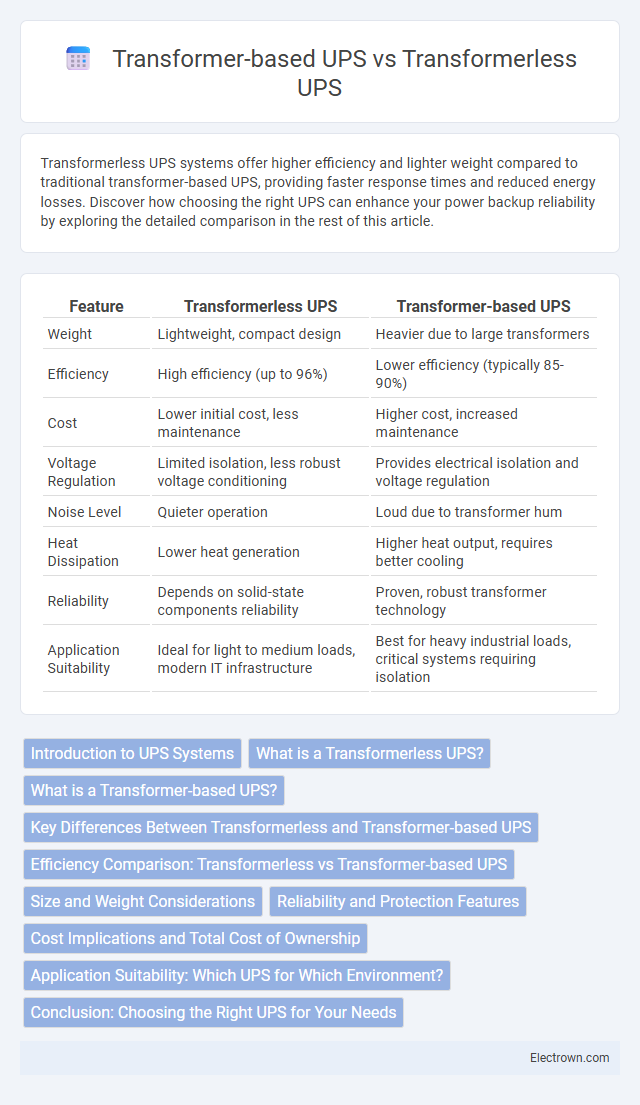Transformerless UPS systems offer higher efficiency and lighter weight compared to traditional transformer-based UPS, providing faster response times and reduced energy losses. Discover how choosing the right UPS can enhance your power backup reliability by exploring the detailed comparison in the rest of this article.
Table of Comparison
| Feature | Transformerless UPS | Transformer-based UPS |
|---|---|---|
| Weight | Lightweight, compact design | Heavier due to large transformers |
| Efficiency | High efficiency (up to 96%) | Lower efficiency (typically 85-90%) |
| Cost | Lower initial cost, less maintenance | Higher cost, increased maintenance |
| Voltage Regulation | Limited isolation, less robust voltage conditioning | Provides electrical isolation and voltage regulation |
| Noise Level | Quieter operation | Loud due to transformer hum |
| Heat Dissipation | Lower heat generation | Higher heat output, requires better cooling |
| Reliability | Depends on solid-state components reliability | Proven, robust transformer technology |
| Application Suitability | Ideal for light to medium loads, modern IT infrastructure | Best for heavy industrial loads, critical systems requiring isolation |
Introduction to UPS Systems
Uninterruptible Power Supply (UPS) systems provide critical backup power to prevent data loss and equipment damage during electrical outages. Transformer-based UPS units offer voltage isolation and enhance power quality through electromagnetic isolation, making them suitable for industrial applications requiring stable output. Transformerless UPS systems are lighter, more efficient, and compact, often preferred in data centers and office environments where energy efficiency and space-saving are prioritized without compromising power reliability.
What is a Transformerless UPS?
A Transformerless UPS is a power backup system that operates without the bulky and heavy isolation transformer, resulting in higher efficiency, reduced weight, and smaller size compared to traditional transformer-based UPS units. It utilizes advanced power electronics and high-frequency switching technology to provide voltage regulation, power conditioning, and uninterrupted power supply while maintaining electrical isolation through design rather than a physical transformer. Transformerless UPS systems are widely used in applications requiring energy savings, space constraints, and improved electrical performance.
What is a Transformer-based UPS?
A Transformer-based UPS utilizes a built-in transformer to isolate and regulate electrical voltage, providing robust protection against surges, spikes, and electrical noise. These UPS systems are known for their reliable voltage stabilization, isolation capabilities, and ability to support heavy loads, making them suitable for sensitive industrial and medical equipment. Your choice of a transformer-based UPS ensures enhanced durability and efficiency in environments with unstable power supply.
Key Differences Between Transformerless and Transformer-based UPS
Transformerless UPS systems deliver higher efficiency and lighter weight by eliminating bulky transformers, allowing for a more compact design and reduced energy losses. Transformer-based UPS units provide galvanic isolation, enhancing safety and reducing electrical noise, which is critical for sensitive equipment in industrial and medical applications. While transformerless UPS offers better efficiency and cost-effectiveness for general use, transformer-based UPS remains preferred where isolation and robustness are paramount.
Efficiency Comparison: Transformerless vs Transformer-based UPS
Transformerless UPS offers higher efficiency levels, typically ranging from 95% to 98%, by eliminating bulky transformers and reducing energy losses during power conversion. Transformer-based UPS systems generally have lower efficiency, often between 85% and 92%, due to inherent core and copper losses within the transformer unit. Advances in power electronics and digital control enable transformerless designs to deliver superior energy performance, especially under partial load conditions.
Size and Weight Considerations
Transformerless UPS systems offer significant advantages in size and weight compared to transformer-based UPS units, often being up to 50% lighter and more compact due to the absence of bulky transformers. This reduction in volume and mass translates into easier installation and more efficient use of available space, making transformerless designs ideal for environments with spatial constraints. Transformer-based UPS units, while heavier and larger, provide galvanic isolation and enhanced surge protection, which may be necessary in specific industrial or sensitive applications despite their increased footprint.
Reliability and Protection Features
Transformerless UPS systems offer higher efficiency and quicker response times due to fewer components generating heat, enhancing overall reliability and reducing maintenance needs. Transformer-based UPS units provide superior galvanic isolation, ensuring robust protection against electrical disturbances and noise, which is critical for sensitive equipment. Understanding your power protection requirements helps to choose between the lightweight, efficient transformerless option and the inherently safer, isolation-focused transformer-based UPS.
Cost Implications and Total Cost of Ownership
Transformerless UPS systems generally offer lower upfront costs and higher energy efficiency compared to transformer-based UPS, resulting in reduced electricity expenses over time. The absence of heavy transformers leads to a smaller footprint and easier maintenance, decreasing operational costs and boosting total cost of ownership. Your choice between the two should consider not only initial investment but also long-term savings driven by efficiency and maintenance requirements.
Application Suitability: Which UPS for Which Environment?
Transformerless UPS units are ideal for environments that demand high efficiency, compact size, and quieter operation, such as data centers, office spaces, and communication systems where space and energy savings are critical. Transformer-based UPS systems excel in industrial settings with heavy electrical loads and require strong isolation and surge protection, making them suitable for manufacturing plants and facilities with sensitive or high-power equipment. Your choice depends on balancing efficiency needs with environmental robustness and electrical isolation requirements.
Conclusion: Choosing the Right UPS for Your Needs
Transformerless UPS systems offer higher efficiency, lighter weight, and reduced size compared to transformer-based UPS units, making them ideal for applications requiring compact and energy-saving solutions. Transformer-based UPS units provide superior electrical isolation, better surge protection, and robustness under harsh conditions, which is crucial for sensitive or industrial equipment. Selecting the right UPS depends on balancing factors like load sensitivity, installation environment, efficiency requirements, and budget constraints to ensure optimal power protection.
Transformerless UPS vs Transformer-based UPS Infographic

 electrown.com
electrown.com